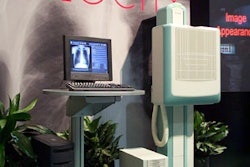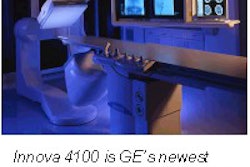WASHINGTON, D.C. - More powerful and refined imaging techniques will improve the detection and diagnosis of aneurysms, researchers said Tuesday at the American Society of Neuroradiology (ASNR) meeting in Washington, DC. The rising star is CT angiography (CTA), although MR angiography (MRA) does have its advantages, according to Dr. Joseph Heiserman, Ph.D., of the Barrow Neurological Institute in Phoenix.
CTA is minimally invasive; the contrast agent can be injected into the veins rather than the arteries; and it can rapidly produce many images of the region of the circle of Willis, Heiserman said during a press conference.
"When the study is done well -- when the bolus arrives at just the right time and the technical parameters are chosen so that the resolution is very high -- it produces about 100 images of the area of the aneurysm," he added.
The images can be studied as is, or digitally reformatted in several ways. The downside is that some of the reformatting methods are time-consuming, "so it’s difficult to produce the images in an efficient way when you’re running a clinical service," Heiserman said. Multiplanar reformatted images can also be tricky to read, he said. In that respect, "CT angiography is much more like angiography than it is like CT."
On the other hand, in patients with subarachnoid hemorrhage, CTA may be the only modality needed for pretherapeutic patient selection, and the new 16-slice scanners will probably prove even more accurate, he said.
Dr. Noriko Salamon, visiting assistant professor of radiology at the University of California, Los Angeles, also spoke in favor of CTA, particularly for the evaluation of carotid ophthalmic aneurysm.
Aneurysms of the tiny ophthalmic artery are rare, Salamon said, "but when you have one, it is difficult to diagnose and difficult to treat."
She noted that in recent tests, CTA has outperformed digital subtraction angiography (DSA) in a select group of 30 patients with an aneurysm of the carotid ophthalmic artery. The CTA exam was either equal or better than DSA in measuring the size of the sac and neck of the aneurysm, she said.
CTA proved to be better than DSA in detecting mural thrombus, calcification, and the origin of the ophthalmic artery -- all characteristics that are important when making decisions about therapy, according to Salamon.
"Neurosurgeons sometimes don’t want to operate when the calcification is located in the neck of the aneurysm, because the clips are put on at the neck," she said. CTA is able to provide the right kind of information for cases that would otherwise be difficult to diagnose, she said.
MRA still valuableThe main advantage of MRA is that it is completely noninvasive, particularly when time-of-flight techniques are used, Heiserman said. As a result the technique is especially useful in asymptomatic patients.
The downside is that MRA produces too many false positives to be really useful in the general population, where the incidence of undisclosed aneurysms is only about one in 20. However, "in high-risk populations -- people with autosomal polycystic kidney disease and possibly in patients who have relatives with a prior subarachnoid hemorrhage -- this completely noninvasive method may be appropriate," he said.
Heiserman added that his institution in Phoenix has recently acquired a 3-tesla scanner, and early data show that this more powerful machine will provide increased resolution, as well as a reduction in background signal intensity.
"Aneurysms (are) being better defined, and the increased visualization of flow within vessels allows us to distinguish vessels from adjacent aneurysms," Heiserman said. "Magnetic resonance angiography, I believe, is going to benefit greatly from this new technology."
By Michael SmithAuntMinnie.com contributing writer
April 30, 2003
Related Reading
CMS sets date for expanded MRA coverage, April 17, 2003
3-D power Doppler challenges standard aneurysm visualization, April 2, 2003
Pseudoaneurysm size affects success of thrombin injection with US, April 1, 2003
Transthoracic ultrasound detects adequate reperfusion after anterior MI, October 30, 2002
Quick ultrasound screening for AAA recommended in older men, September 27, 2002
Copyright © 2003 AuntMinnie.com



















